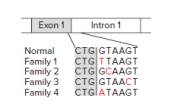
Concept explainers
Adermatoglyphia (described previously in Problem 18 in Chapter 3) is an extremely rare condition where people are born without fingerprints; only four families on earth are known to have this condition. The condition is inherited in an autosomal dominant fashion and is due to point mutations in a gene on chromosome 4 called SMARCAD1.
The following figure shows that different point mutations—all near the 5′ end of the same intron of SMARCAD1—were found in each of the four families. All four mutations prevent the expression of a skin-specific transcript that uniquely contains exon 1, the first exon of this transcript; no other SMARCAD1 mRNAs contain this exon. In the figure, the final three bases in the RNA-like strand of exon 1 are shaded, while the first six bases of intron 1 are unshaded.

| a. | No ATG sequence normally exists in exon 1 upstream of the sequence shown. Which part of the skin-specific mRNA corresponds to exon 1? |
| b. | What aspect of gene expression is likely to be affected most directly by these mutations? |
| c. | Are these mutations more likely to cause loss of function or gain of function? |
Want to see the full answer?
Check out a sample textbook solution
Chapter 8 Solutions
Genetics: From Genes to Genomes
- . The physicist Stephen Hawking, famous for his theories about black holes, has lived past the age of 70 withamyotrophic lateral sclerosis (ALS), a paralyzing neurodegenerative disease that is usually fatal at a muchyounger age. Recently, geneticists discovered that amajor cause of ALS is the unusual expansion of ahexanucleotide repeat (5′-GGGGCC-3′) that lieswithin a gene called C9ORF72, at a location outside ofthe gene’s open reading frame (ORF). A single expanded allele is sufficient to cause ALS, but the reasonthe disease allele is dominant remains unclear. Someexperimental results support the theory that the allelemakes a toxic RNA containing the expanded repeat. Ifthis theory is correct, in what ways is the mutant ALScausing allele similar to the mutant allele that causesHuntington disease? In what ways is it similar to themutant allele that causes fragile X syndrome?arrow_forwardFamilial retinoblastoma, a rare autosomal dominant defect, arose in a large family that had no prior history of the disease. Consider the following pedigree (the darkly colored symbols represent affected individuals): a. Circle the individual(s) in which the mutation most likely occurred. b. Is the person who is the source of the mutation affected by retinoblastoma? Justify your answer. c. Assuming that the mutant allele is fully penetrant, what is the chance that an affected individual will have an affected child?arrow_forwardThe genetic alteration responsible for sickle-cell anemia in humans involves: a transition mutation from A to G, substituting glutamic acid for valine in a-globin a transversion mutation from T to A, substituting valine for glutamic acid in b-globin a transition mutation from T to C, substituting valine for glutamic acid in b-globin a transversion mutation from G to C, substituting glutamic acid for valine in a-globin a frameshift mutation of one ATC codon, removing glutamic acid from b-globinarrow_forward
- Each of the four types of structural chromosomal mutations is illustrated below. Label each picture with the type of chromosomal mutation that has occurred.arrow_forwardThe DNA of a deletion of alpha bacteriophage has a length of 15 micrometers instead of 17 micrometers? How many base pairs are missing from this mutant?arrow_forwardIn the human gene for the beta chain of haemoglobin (the oxygen-carrying protein in the red blood cells), the first 30 nucleotides in the amino-acid-coding region is represented by the sequence: 3'-TACCACGTGGACTGAGGACTCCTCTTCAGA-5'. What is the sequence of the partner strand?arrow_forward
- Sandhoff disease is due to a mutation in a gene that encodes a proteincalled hexosaminidase B. This disease has symptoms that aresimilar to those of Tay-Sachs disease. Weakness begins in the first 6 months of life. Individuals exhibit early blindness and progressive mental and motor deterioration. The family in the pedigree shown below has three members with Sandhoff disease, indicated with black symbols.arrow_forwardYou have a patient in your clinic presenting symptoms of cystic fibrosis. You screen their CFTR gene for mutations, and find the following list: CFTR 320 L V CFTR 341 S W CFTR 528 E D CFTR 976 F Q CFTR 1235 S R Which mutation(s) are likely causing cystic fibrosis in this patient? You also sequence a newborn family member of this patient. They have all of these same mutations, other than the one at position 976, and no other mutations in CFTR. Do you predict this person will develop cystic fibrosis? Explain why.arrow_forwardYou are studying a small eukaryotic gene of about 2000 bp in length. About how many copies of histone H4 would you expect to find along this region of the chromosome?arrow_forward
- A gene contains 30% thymine. What is the percentage of pyrimidines present in this segment? Explain.arrow_forwardWhat is a copy number variant in genetics?arrow_forwardThe D1S80 locus is located on human chromosome 1 and is characterized by a repeating 16 base pair (bp) sequence. Alleles for this locus vary depending on the number of repeats present, thus affecting the size of the locus. The D1S80 locus also contains two conserved sequences, a 32bp sequence at one end and a 113bp sequence at the other end. If the DNA of an individual is targeted for D1S80 amplification, and one of the resulting amplicons is approximately 785bp in size, how many repeats would be present in this D1S80 allele? The amplicon of interest is indicated by a red arrow in the diagram below.arrow_forward
 Human Heredity: Principles and Issues (MindTap Co...BiologyISBN:9781305251052Author:Michael CummingsPublisher:Cengage Learning
Human Heredity: Principles and Issues (MindTap Co...BiologyISBN:9781305251052Author:Michael CummingsPublisher:Cengage Learning
